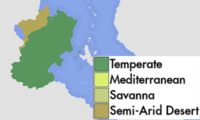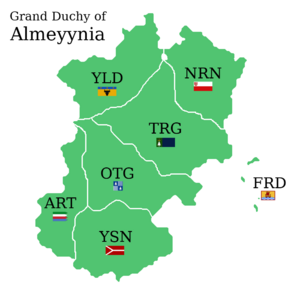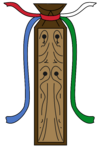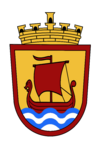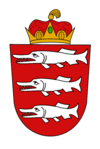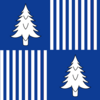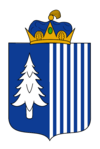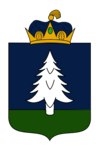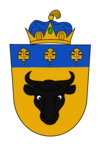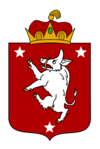Almeyynia: Difference between revisions
| Line 116: | Line 116: | ||
|[[File:Arath_Flag.png|100px]] | |[[File:Arath_Flag.png|100px]] | ||
|[[File:Arath.png|100px]] | |[[File:Arath.png|100px]] | ||
|'''Arath''' - | |'''Arath''' - Arathakantia | ||
|Kinimi-h'yto | |Kinimi-h'yto | ||
|- | |- | ||
Revision as of 02:32, 8 July 2020
Grand Duchy of Almeyynia Groosdacha Almeyyniat (Almeyyda) H'yitt Almenia (Arath'i) | |
|---|---|
| Motto: "Humilibus Dat Gratiam" "He Gives Grace to the Humble" | |
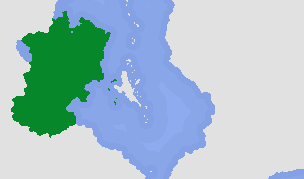 | |
| Capital and largest city | Yeyystikka |
| Official languages | Almeyyda, Arath'i |
| Demonym(s) | Almeyynian |
| Government | Constitutional Monarchy |
• Grand Duke | Villem II |
• Prime Minister | Gilhaart Yenssn |
| Legislature | Tinga |
| Groostinga | |
| Friyytinga | |
| Independence | |
• Treaty of Hallan | 1816 |
| Population | |
• 2020 estimate | 17,132,000 |
| Currency | Kroeno (ҟ) |
| Date format | dd/mm/yyyy AD |
| Driving side | right |
| Internet TLD | .al |
The Grand Duchy of Almeyynia (Almeyyda: Groosdacha Almeyyniat, Arath'i: H'yitt Almeina) is a constitutional monarchy in the world of Anteria. It is bordered by Hegyseg and Medovia to the south. The western boder, south of the great lake, is dominated by the Sky Mountains while the remainder of the country is covered in temperate plains and dotted with forrests.
Etymology
Almeyynia comes from the the Almeyyda for "Land of Almeyy." Almeyy (which means "Oaken-One") was the semi-legendary chief who united the disperate tribes which would come to be known as the Almeyyda. A person from Almeyynia is known as an Almeyynian. This is not to be confused with or identified with the ethnic group of the Almeyyda peoples, as anyone who is a citizen of Almeyynia is a full Almeyynian no matter their ancestry.
History
Tribal Period (TAQ 174)
For thousands of years the regions which make up Almeyynia were not regularily inhabited. Various tribal peoples moved through and among the region without settling. By the late first century BCE there is evidence of various Narric and Arath tribes. The Narric who preferred to live in the lowlands and near the sea settled mostly near the sea and the rivers flowing to it. On the other hand, the Arath peoples, who already at this time kept sheep and goats, settled in the Sky Mountains. While the Arath more or less remained united the smaller Narric tribes were often involved in bitter power struggles among themselves as evidenced by both oral history and archaeological evidence of battles near Narric sites. In the mid second century CE a leader of a Narric tribe from central Almeyynia named Almeyy rose to prominence. Using both diplomacy and warfare he was able to unite the majority of the Narric peoples under his rule. By 167 Almeyy had extended his rule into the northern desert and to the north shores of the sea. It is at this time the Narric began to refer to themselves as Almeyyda, that is, the people of Almeyy.
Almeyyda Confederacy (174-1487)
Following the death of Almeyy in 174 the various tribal rulers under him met at his newly founded capital Oskka. There, many of the chiefs vowed their support to his son, Haldo. Haldo would rule his tribe from Oskka while the remaining tribes would each continue to rule their territories and pay an annual tribute to Haldo as well as promising to aid him in military matters. It was at this time that Yeyystikka became the centre of the southern Almeyyda tribes (called the Yeyystinia). During the time of the Almeyyda Confederacy many of the regional divisions (later becoming the Kantia) began to be established. For the first five hundred years the Confederacy was stable and functioning as intended, however, after the death of High Chief Almeyy V (d. 632) and the incompetant rule of his son Hirild the Weak the various tribes, now in a fully settled state, began acting more independently. An example of this is Yeyystinia Chief Alheert II adopting the swan as his personal symbol, something which until this time was only granted by the High Chief.
Greater Almeyynia (1487-1814)
By the 15th century the Almeyyda Confederacy existed in name only. In 1472 Chief Riss of Yellend began to style himself the Duke of Yellend and with the help of Yeyystinia in the south began to consolidate power and organized the Kingdom of Greater Almeyynia in 1487 and included not only the former territory of the Almeyyda Confederacy but also included some of the territory which Almeyy once ruled. At this time the Almeyyda tribes were disbanded and reorganized into Kantia and Dachia. Those whom Riss favoured, including the Duke of Yeyystinia were awarded controll over large areas of land. By 1593 the territory of the Duke of Yettstinia was so large that he became known as the Grand Duke of Almeyynia. During the time of Greater Almeyynia, the Grand Duke's claims extended into the Sky Mountains. However, nothing had been done to properly claim them as the general belief was they they were an unpenitrable and unhospitable wall. In 1620 missionary Rold Villemsn made contact with the Arath. Through his work many of the Arath were converted to Christianity. Fearing that as more and more contact was made the Almeyynians may try to make their claim by force in 1756 First Brother Ninha of the Arath sent a delegation to Grand Duke Haldo III to work out a treaty. The treaty, called the Brotherly Accord, was signed in 1759 and protected the land and rights of the Arath while swearing fealty to the Grand Duke.
Independence (1814-1816)
At the turn of the 19th century the power of Greater Almeyynia began to wane as the northern territories began to agitate for independence. During the northern strife, seeing that the fall of Greater Almeyynia was imminent, Grand Duke Hirild V declared that the Grand Duchy of Almeyynia was no longer a member of the greater kingdom. This was largely ignored by King Riss IX as he was busy dealing with the militant groups in the north. By 1816, at the Treaty of Hallan, Greater Almeyynia was disolved and portions of what remained were partitioned. It was at this time when South Yellend was made a part of the Grand Duchy of Almeyynia.
The Reforming Dukes (1816-1950)
Modern Almeyynia (1950-)
Geography
The majority of Almeyynia is found within the temperate climate zone in the south and west hemispheres. The northernmost area of the nation is classified as being semi-arid desert. It has access to the south ocean by way of the inland sea which it borders on the west.
South and central Almeyynia is a mix of plains and deciduous forrest while the north dominated by stretches of semi-arid prairie. South of the great lake, and helping form the western border is the Sky Muntain range. Rivers which have their source here run east towards the sea.
Demographics
Health
Education
Ethnicity
According to the most recent Almeyynian cencus the largest self-reported ethnic group is Almeyyda (81%) followed by Arath (11%) mostly concentrated in the west, Medovian (5%) mostly in the south, and other (3%). While some Medovians are recent immigrants, the majority fled to Almeyynia during the 21 year Medovian Civil War (1777-1798).
Languages
There are two official languages in Almeyynia, Almeyyda and Arath'i. Almost all people (98%) can speak at least one of the two official languages. Almeyyda has the largest reach with 91% of the population able to speak it. The other majority language, Arath'i is spoken by 13%. The majority of Arath'i speakers are the Arath of the Sky Mountains, but it is also used by those who live near major Arath populations and Arath enclaves. Many government officials also have a working knowledge of Arath'i. Since the signing of the Brotherly Accord in 1781 the Grand Duke and his family are also expected to know and be able to speak Arath'i. The majority of the Medovian population in Almeyynia speaks Almeyyda, having been in Almeyynia for over 200 years. However, it is still used extensively as the liturgical language of the Medovian Apostolic Church in Almeyynia.
Religion
Since the 1883 Act of Toleration there is no official religion of Almeyynia. However, the years of an official church has left its mark with almost 90% of the population self-identifying as Christian. The largest religious group (83%) is the Eyangelikka u Katolikka Kirka Almeyyniat (the Evangelical and Catholic Church of Almeyynia) which subscribes to the Lutheran Confessions as found in the Book of Concord. Other Christian groups include the Medovian Apostolic Church (4%) and the Friyykirka (Free Churches) (2%). In the last number of years there has been a rise in those who claim to follow traditional Arath customs (7%). Other religious groups include Judaism (2%), Islam (1%), and no religion (1%).
Government
The Grand Duchy of Almeyynia is a constitutional monarchy with a bicameral legislature. The head of state is the Grand Duke, a hereditary position which is confirmed on ascendency by the legislature (Almeyyda: Tinga). As head of state, the Grand Duke is able to issue proclamations and is also the one who signs bills into law after being passed by the Tinga. The Tinga is a bicameral house made up of an elected lower chamber, the Friyytinga (lit. Free Legislative Council) and an appointed upper chamber, the Groostinga (lit. Great Legislative Council). The Friyytinga is made up of members elected by mixed-member proportional voting representing geographical areas with a number of free seats to ensure proportional represntation. The party with the most seats is first approached about being able to form government if they can form a coalition. If they cannot the invitation is passed to the party with the second highest number of seats. The Groostinga is made up of members appointed by the Grand Duke in cooperation with the leaders of the region they are representing as well as trusted advisors. Members of the Groostinga are chosen to represent the various regions of Almeyynia as well as other special interest groups and fields. Much of what governs governing is custom and tradition. However, during the 20th century there was a push to codify this in a constitution. And so while custom and tradition are still very important the requirements and limits on government are enshrined within the constitution (Grooskarta Almeyyniat).
Regional Government
Almeyynia is divided into six regional governments who govern in place of the Crown and one autonomous region representing the traditional lands of the Arath. The six regions (Kantia) are governed on behalf of the Grand Duke in a way similar to the national level. On the other hand, the autonomous region (Arathakantia) is self governing in the traditional ways of the Arath following family and clan structures. Following the terms of the Brotherly Accord each time there is a new head of the Arath (called the First Brother) or Grand Duke there is a meeting of the rulers where the First Brother swears fealty to the Grand Duke and the Grand Duke promises protection and autonomy. In order to help celebrate this arrangement every five years the signing of the Brotherly Accord is reinacted leading up to a week of celebration accross Almeyynia.


